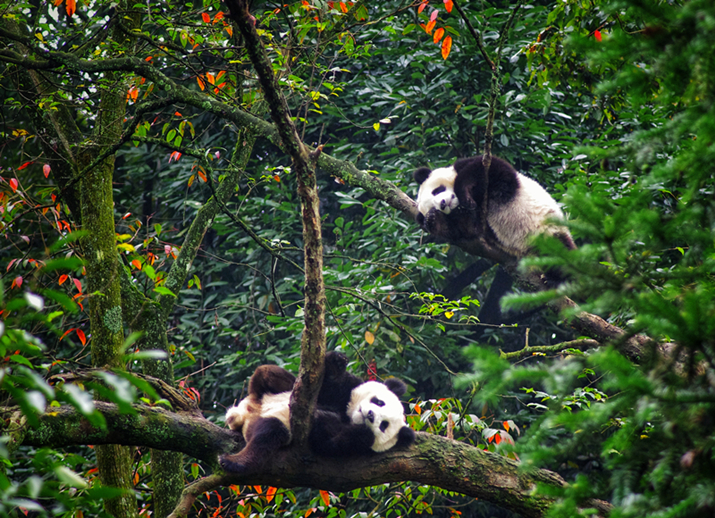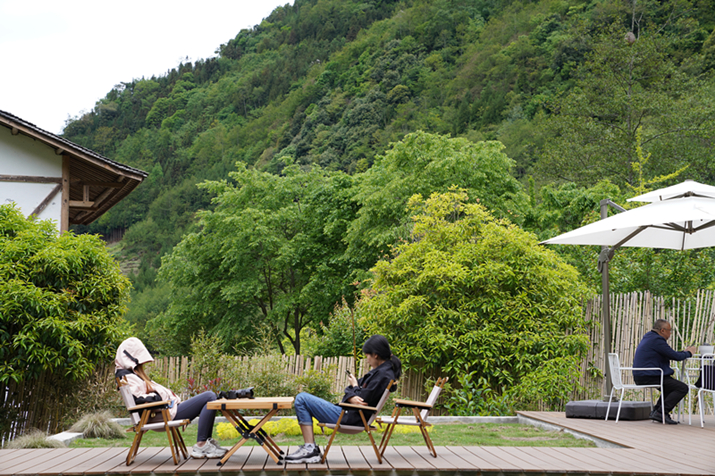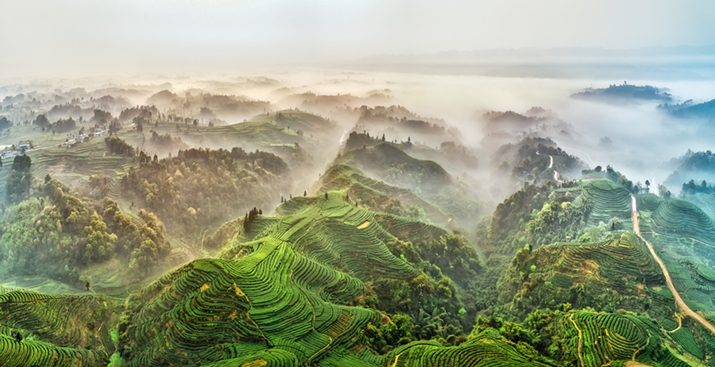|
||||||||||
| Home Nation World Business Opinion Lifestyle ChinAfrica Multimedia Columnists Documents Special Reports |
|
||||||||||
| Home Nation World Business Opinion Lifestyle ChinAfrica Multimedia Columnists Documents Special Reports |
| Current Cover Story |
| Green Growth |
| Ya’an finds the balance between wildlife preservation and social development |
| Reporting from Ya’an Xia Yuanyuan 丨VOL. 15 June 2023 ·2023-05-30 |

Two pandas rest on a tree in Bifengxia Giant Panda Base in Ya’an City, Sichuan Province, on 11 May (CAO SHENGLI)
Zhang Jiliang and Wang Youliang, two villagers from Baoxing County, Ya’an City, southwest China’s Sichuan Province, came close to wild giant pandas on 12 May while working in the virgin forest at an altitude of 2,700 metres above the sea level in Liangzigou, the source of the Qingyi River.
“The giant panda drank river water for three full minutes before walking towards the direction we were hiding,” Zhang said. In order not to affect the giant pandas, they took the initiative to give way.
Shortly before that, the main supervision and protection station under the Giant Panda National Park in Ya’an’s Baoxing County recorded images of a wild giant panda by drone for the first time. While taking a break, the giant panda appeared relaxed and comfortable, occasionally looking up to see the scenery.
In Ya’an, the hometown and cradle of giant pandas, it is not rare to encounter the animal in the wild. Ya’an is also the location of the Sichuan Giant Panda Sanctuaries, included on the World Heritage List in 2006, and the core area of the Giant Panda National Park. All eight counties (districts) of Ya’an have the traces of wild giant pandas.
The frequent appearance of giant pandas points to the fact that the habitat of giant pandas is constantly improving. Behind this is the great efforts made by Ya’an people to give priority to ecology and green development.

A beautiful village in Shimian County, Ya’an City, Sichuan Province (LIU YONG)
Favourable habitat
Located at the 30 degrees north latitude, Ya’an is a natural paradise blessed with mountains, canyons, waterfalls and frequent clouds.
“Ecology is the biggest advantage of Ya’an,” said Liu Jie, chief engineer at the Ya’an Bureau of Ecology and Environment. As an important part of the ecological barrier upstream of the Yangtze River and a place of water resource protection, Ya’an is known as a “green lung” and an “animal and plant gene bank,” with a forest coverage rate of 69.42 percent.
Ya’an’s unique natural environment has won the favour of giant pandas. According to the result of the fourth giant panda census released in 2015, there are 340 wild giant pandas in Ya’an, accounting for 18 percent of the wild panda population in China, which make the place one of the cities and prefectures with the largest number of giant pandas in China.
In December 2016, the Chinese government adopted the scheme to pilot a national park for giant panda protection, which kicked off the highest level of protection for giant pandas and their habitats. On 12 October 2021, the Giant Panda National Park was officially established and covers a total area of about 27,000 square km, spanning Sichuan, Shaanxi and Gansu provinces. Some 39.45 percent of Ya’an’s administrative divisions, or 5,936 square km, is classified as the Giant Panda National Park. The Ya’an area of the park involves 70 administrative villages in 22 townships in Baoxing, Tianquan, Lushan, Yingjing and Shimian counties. Ya’an has the largest area, the highest proportion of pandas, the most complete mountain system and the most counties in the park.
To better protect wild pandas, the national park has been divided into core protection areas and areas under general control. They are put under the management of strict ecological preservation system, which involves different levels of control over human activities within and near the protected area.
“This means that the traditional development method of exploiting mountain resources should be transformed,” Liu told ChinAfrica.
As the land is allocated for giant pandas, and the ecological red line must not be crossed, where is the space for economic development? How to solve the contradiction between ecological protection and development?
“Economic development is for people’s livelihoods, and environmental protection is for people’s livelihoods as well. In the process of transformation and development, the first consideration should be given to the people. Only when the people benefit can they wholeheartedly support the construction of the Giant Panda National Park,” said Liu.
Currently, with the improvement of the environment, new business opportunities are constantly emerging, enabling locals to rediscover their smiles. Ya’an is slowly unfolding a picture of harmonious coexistence and mutual prosperity between humans and nature.

Tourists enjoy a wonderful time in a farm stay located near the Giant Panda National Park in Baoxing County, Ya’an City, Sichuan Province, on 9 May (YU XIANGJUN)
Green is gold
In Longcanggou Township in Yingjing County, square bamboos get fresh sprouts in May. The area is home to a bamboo forest base covering 3,100 mu (206.7 hectares).
Wannian is a village situated northwest of Longcanggou, with 2,780 residents. It is known to be the first village at the south entrance to the Giant Panda National Park, just 20 km from the core protection zone. This village once served as a distribution centre for goods along the ancient Tea Horse Road. Its economy was once based on white marble mining, logging, and hydroelectricity generation, as was the case with most villages in Ya’an. However, the extraction of raw resources has led to serious pollution, so there was an urgent need to change this model.
In 2017, as part of the Giant Panda National Park pilot project, 48.7 percent of Yingjing County was allocated to the park, including Wannian Village. In accordance with the requirements of the ecological preservation, hydroelectric power stations, coal mines and woodworking factories were all closed, and the villagers had to move out of the mountain, much to their regret.
“At that time, many villagers didn’t understand and thought it was the giant panda that competed with people for food,” Bi Han, the first secretary of the CPC Wannian Village Branch, told ChinAfrica. The way to solve the problem is to develop new industries and find a new development path for villagers.
The bamboo industry was the first step in the transformation and development of the village. Square bamboo shoots, which are found all over Yingjing County, are one of the giant pandas’ favourite foods. In the past, villagers did not know what to do with it or how to take care of it, so the income from bamboo shoots was low.
In 2017, the village invited agricultural experts who helped the villagers to plant 500 mu (33 hectares) of bamboo on a trial basis, which started to bring benefits in 2021, after more than three years of growth.
According to Tao Yonghu, deputy secretary of the CPC Wannian Village Branch, each mu (0.07 hectares) of bamboo forest can produce more than 700 kg fresh bamboo shoots. “Currently, the market price of the bamboo shoot is 6.4 yuan ($0.9) per kg, which means 1 mu can generate close to 5,000 yuan ($714) in earning,” he said.
At the end of 2021, the village started to centrally develop square bamboo bases again. Villagers receive a share of profit for their land and are then allocated 200 yuan ($28.6) per mu as land-use fee each year. The land is handed over to the village shareholding economic cooperative society and the dividends are paid after the income is generated. Today, more than half of the villagers are involved in square bamboo plantation.
According to Bi, the collective income of Wannian Village amounted to 238,000 yuan ($34,000) in 2021 and 640,000 yuan ($91,428) in 2022. In the future, the village will introduce environmentally friendly bamboo processing enterprises to increase farmers’ incomes and extend the bamboo industry chain by improving its added value. At the same time, the village will develop bamboo shoot picking sites and tourist trails to promote tourism development.
“Now, the villagers have changed from forest fellers to forest protectors, and the economy of Yingjing has changed from selling stones to ‘selling ecologic products,’” Yang Chenglin, deputy director of the Publicity Department of the CPC Yingjing County Committee, told ChinAfrica. 
A tea plantation in Mengding Mountain, Ya’an City, Sichuan Province (COURTESY)
Ecological umbrella
The giant panda is considered the flagship species of global biodiversity conservation. Protecting giant pandas means protecting the entire habitat, and other species in the same area are also sheltered under this “ecological umbrella.”
In the Ya’an section of the Giant Panda National Park, protected animals such as takin, golden snub-nosed monkey and Temminck’s tragopan are currently making frequent appearances. Rare fish species including Schizopygopsis Baoxingensis and Gobiocypris Rarus that had disappeared for many years reappeared.
The inhabitants of Ya’an, who had benefitted from the ecological dividend, gradually realised that protecting biodiversity means protecting humanity itself. They started spontaneously joining the team to protect the environment.
Hu Tailun is a resident of Fazhan Village in Longcanggou Township where hunting was a family tradition for generations. Previously, he often hunted birds in the mountain, but after the establishment of the Giant Panda National Park, he left the reserve with his family.
Thanks to local government’s efforts to raise people’s awareness of environmental protection, Hu gradually changed his mind. He now operates agritainment business in his house, and works as a bird guide. Today, he accompanies Chinese and foreign tourists in their quest to observe and photograph rare birds in Longcanggou, while reminding visitors to observe birds in a civilised way and protect them.
“Protection through development, and development through protection are new fruitful development paths explored by Ya’an in which people and giant pandas live in harmony,” said Liu. “The protection of giant pandas is a long process that has taken it from an ‘endangered’ species to a ‘vulnerable’ species in the hope that it will one day become a species of ‘least concern’. Ya’an will continue to protect giant pandas and provide the international community with China’s experience in biodiversity conservation.”
| About Us | Contact Us | Advertise with Us | Subscribe |
| Copyright Beijing Review All rights reserved 京ICP备08005356号-5 京公网安备110102005860号 |